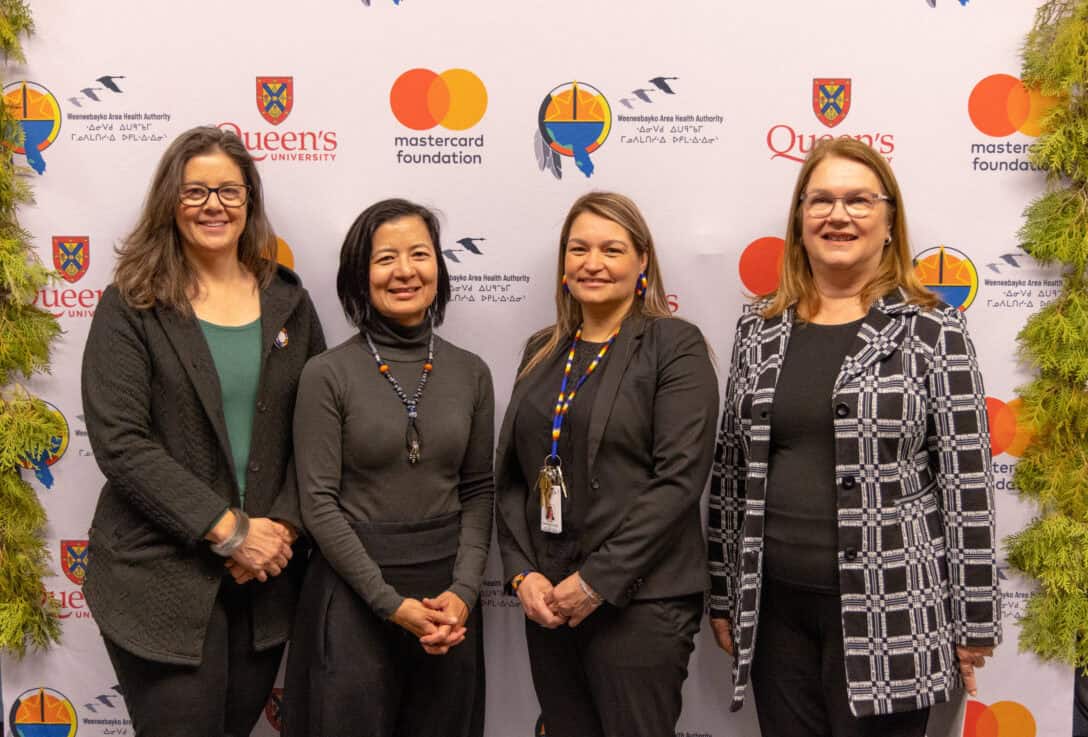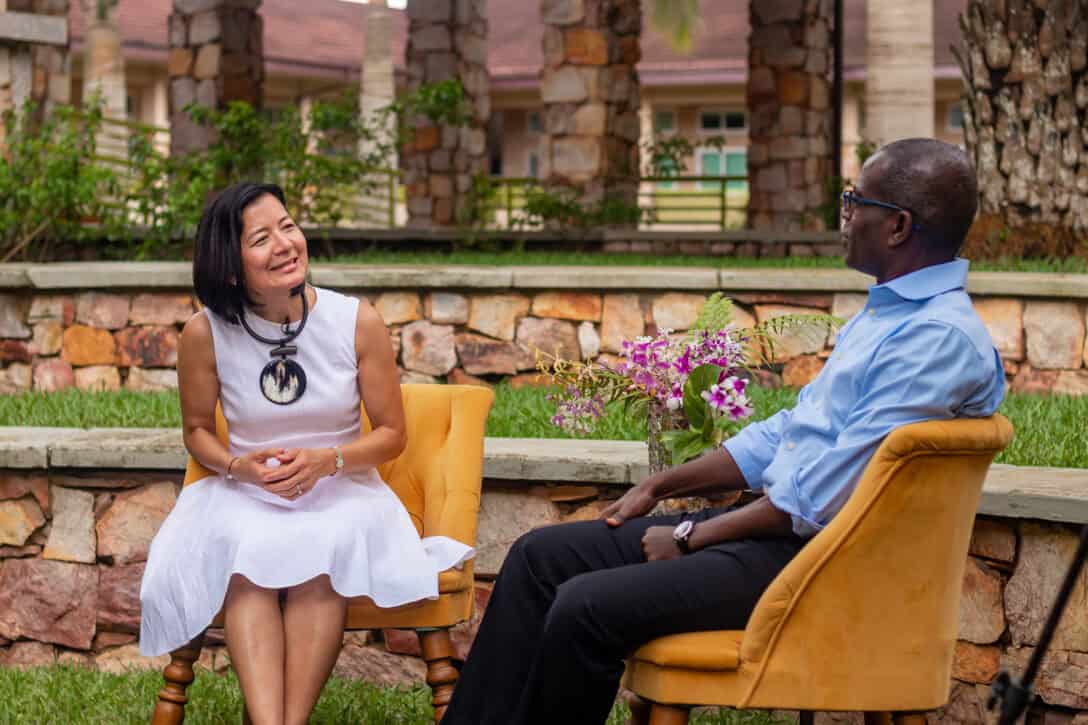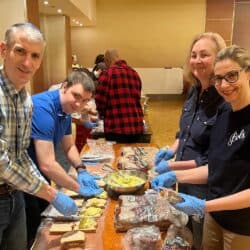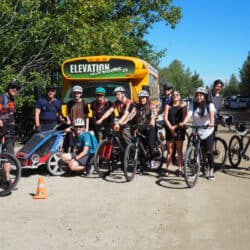The Canadian-registered Mastercard Foundation is one of the largest charities in the world and has a global/local mandate, with its Young Africa Works 2030 strategy and a commitment to reaching 100,000 Indigenous youth in Canada.
In winter, a community ice road links Moosonee and Moose Factory, one of a few ice roads that make vital connections between the Indigenous communities located on the shores of James Bay.
Reeta Roy, president and CEO of the Mastercard Foundation, who is Malaysian by birth and lives in Kigali, Rwanda, travelled the road from Moosonee to Moose Factory in winter 2023 to meet with the Weeneebayko Area Health Authority. With the foundation and Queen’s University, the health authority is building a health education campus in Moosonee to increase the number of trained Indigenous health workers in the community.

“I had not been to that part of Ontario before, and I’d never seen an ice road before. We drove on it and I experienced the length and understood about the know-how it takes to create these roads, which enable transportation, distribution, and connection across the region,” Roy says. “For me, it was the perfect metaphor about knowledge, Indigenous technology, worldview, innovation, and harmony with the environment. To understand the ecology and the system and the weather and to utilize that knowledge so that communities can connect.”
The foundation’s work is grounded in principles of valuing local knowledge and creating connections. It was established in 2006 by Mastercard International when it issued its IPO (initial public offering). The company endowed the foundation with a gift of shares valued at US$500 million. Today, the Canadian-registered “mega-foundation” is one of the largest charities in the world, with US$46 billion in assets. It disbursed US$1.2 billion to partners in 2022.
The foundation began its work in Africa, which is home to the largest and fastest-growing youth population in the world: 70% of people living in sub-Saharan Africa are under 30. It’s currently active in seven African countries, and its Young Africa Works 2030 strategy envisions a future where 30 million African youth, especially women, have dignified and fulfilling work.
In 2017, prompted by the Truth and Reconciliation Commission’s Calls to Action, the foundation began working with Indigenous partners and communities to support Indigenous youth, a fast-growing cohort that faces significant barriers to educational and economic inclusion. The foundation made a commitment first to reaching 10,000 Indigenous youth, and then 100,000, attaching $500 million to that goal. The vision for its EleV program was co-created with Indigenous youth and communities and aims to build a world where Indigenous youth are living “Mino Bimaadiziwin” – “a good life” in the Anishinaabe language. The Philanthropist Journal spoke with Roy about her approach to philanthropy, the foundation’s global/local mandate, and its approach to systems co-creation and institution-building.
What has most influenced your view of and approach to philanthropy?
It is my own childhood. Growing up in Malaysia, we had very modest means, but my family prized education above all – and especially my mother, after my father died. My mom didn’t have the education she wanted because she was a girl, but she wanted to make sure she did not allow that to continue in the future. My father was a doctor, working in public health, disease prevention – dengue fever, malaria, all those things. He trained in India, and he came to Malaya before independence. One of the stories my mother would tell us about him was that experts would come from the World Health Organization and tell them what to do. They didn’t listen.
The only way to really understand how people experience a problem is to listen to the ones closest to it and to ask them how we can do better.
Reeta Roy, Mastercard Foundation
Throughout my career, I’ve had phenomenal mentors who said, “Always seek to understand.” And the best way to do it is to listen. And so when I think about the practice of philanthropy, where organizations have resources, and we want to try to do the right things and make sure those resources are well deployed, one of the most important things to remember is we don’t know. We don’t always have answers. We may have phenomenal analytical information and data, which can dimensionalize any kind of problem, but when it comes to really understanding how people experience a problem, the only way to do it is to listen to the ones closest to it and to ask them how we can do better.
What’s the opportunity that you see across the very different geographies where you work?
The opportunity is to prepare young people for a world that’s changing, for a world where they will have to be adaptive learners, where they will be creating and shaping their careers. If we do that well, especially for young people who come from families where there have been generations of poverty and exclusion from participation in economic activity and education, that will be transformative – not just for that young person but their family.
Why is it important for the foundation to take a global approach?
When we looked at where we could have a significant impact for the long term, a lot of the data suggested we should do so in Africa, largely because when you look at the particular indicators around educational attainment, retention, enrolment and financial inclusion, the continent of Africa lagged behind the rest of the world. So that was one part. The other was we saw opportunity: a young population, an emerging cohort of entrepreneurs, huge amounts of innovation where people are reinventing what is a classroom, what is a bank, and coming up with ways to reach or close the last miles.
It’s important to have a global view because whether we’re talking about climate change or education – which has a direct impact on economy, on health – we’re completely interdependent. By 2050, one in four young people will be African; if you go out to the end of the century, Africa is going to be the world’s workforce. So it’s not as if we’re doing charity. We need Africa’s contribution and participation to have a healthy, high-functioning global economy. And we need to benefit from the innovations that are going to be coming from that part of the world to solve a lot of the challenges we see around the world.
A focus on creating transformational partnerships
During the pandemic, the foundation provided a $1.5-billion gift to the Africa Centres for Disease Control to deliver COVID-19 vaccines to 65 million people and enable African health institutions to produce vaccines and medical supplies. That partnership and the one with the Moosonee health education campus are examples of the types of transformational partnership work and institution-building the foundation invests in.
We asked Roy about the foundation’s approach to co-creation and institution-building.
Can you share an example of a partnership where you’ve seen the type of transformational outcomes that the foundation seeks?
We were in Ghana not too long ago meeting with young people from different communities, including a group of young people who had been Mastercard Foundation Scholars at Ashesi University. We listened to what has happened post-graduation in terms of businesses they’ve created, employment in public service or in the private sector, and then a couple others who are pursuing higher education degrees. One young man came up with an app which helped with election monitoring in Ghana. Another worked on a business which is doing a lot of things with artificial intelligence. Some spoke about how they are supporting their siblings to get an education. You could tell family dynamics were shifting.

We’ve worked with the university for over a decade, and we’ve been able to deepen that partnership. They’ve added new disciplines into the curriculum and become a leading institution. Their graduates within six months are all employed. Universities across the continent want to learn from this institution. So that journey, which began with a cohort of scholars over a decade ago, has now grown and expanded into not just one institution, but many more.
What have you learned about co-creation from the communities you work with?
Let me start with the spirit of co-creation before we talk about the process. I think the spirit is paramount because it means preparing yourself when you enter into a discussion or an exploration of what a partnership could look like and what it could achieve. We have goals as a foundation, and we have to recognize that other organizations we work with also have goals. What we’re looking for is that alignment.
The actual process of co-creation requires an intellectual investment of time and an emotional investment.
Reeta Roy
The actual process of co-creation requires an intellectual investment of time and an emotional investment, because we’re really trying to understand beyond what we may have read about an organization, a community, or a challenge and really trying to get a sense of some of the intangibles that have to do with the culture. When we ask questions like “How come in Africa more women aren’t accessing education or financial tools to help them build a business?” That’s how we get into the hidden and not-so-hidden barriers. Part of co-creation is surfacing those barriers so they can be addressed.
I would say that in every co-creation process, we learn, we come back together and adjust where we need to pivot, and we continue. It’s a process and a way of thinking and working that’s almost continuous because this work is continuous.
What are the next-frontier questions that are on your mind right now?
If I’m talking about the work in Africa specifically, we’ve set an ambitious target of 30 million young people in dignified and fulfilling work, and when we look at the last dataset at the end of 2023, we’re at 7.1 million people. And there’s a bigger number than that of people going through work-enabling programming.
When we look at what is the single biggest driver that enables young people to make some form of transition and earn a living, it’s clearly around entrepreneurship. And part of that means access to finance that’s affordable. It’s about access to mentors, business development partners, and, depending on whatever it is that they’re creating, access to market.
So that’s going to be a huge focal point across all of our programs. The other is around workforce development and making sure that young people – whether they’re in secondary school, vocational school, or higher education – are actually acquiring relevant skills and knowledge and have the opportunity to do two things: learn in the classroom and learn in a work environment. Whether that work environment is a start-up, a company, or public service, and to make sure that experience is educational, that it’s an experiential education, and it’s developing life skills, teamwork, collaboration, the opportunity to exercise agency and voice to create something of value. Those are two very important areas of focus for us as we go forward.
Education systems aren’t set up to prioritize socio-emotional skills in many countries.
That is not the way, frankly, universities anywhere are set up or education is set up. It’s only been very recently that there’s been recognition of the importance of soft skills or life skills.
For us, it always comes back to listening to young people and listening to educators, particularly those who are extremely progressive and are doing what I would consider cutting-edge work. In Canada, when you listen to Elders about what they see as important in preparing young people for a very dynamic world that’s shifting, often people talk about the importance of knowing who you are. And that’s why, across all of our programs, we prioritize the learning of the Indigenous language, and culture – incorporating a worldview practice into the education experience. So it feels like we all belong.
For us, it always comes back to listening to young people and listening to educators, particularly those who are extremely progressive and are doing what I would consider cutting-edge work.
Reeta Roy
You asked whether I see things which are similar between the African and Indigenous contexts in which we work. And, respectfully, while I recognize the difference in terms of history and location and culture, what has always struck me is that in both the communities we work with in Africa and in Canada, there’s a reverence for Elders. And now that I live in Rwanda and I travel so much here, I see that in families, I see that in language. I see that in how people acknowledge each other.
It comes back to knowing why you’re here and knowing what you love, what you’re passionate about knowing. And that to me is deserving of elevation and making sure that it’s explicit in our programming. It starts by asking the young person “What are you interested in?” In communities in Africa that I’ve visited, many have said, “Nobody has asked me this question before. I’ve always been told ‘You’ve got to do this, or that.’ But someone is asking me ‘What do I care about? What am I interested in?’” That’s incredibly affirming. Maybe the systems weren’t set up that way, but I hope that through the programs we and others support that becomes an embedded part of curriculum methods and approaches. Because to me, it’s fundamental to success and fundamental to sustainability.
It defines achievement not on someone else’s terms, but by being able to articulate a vision for oneself and one’s future and then figuring out how to get there.
Even the term “dignified and fulfilling work” – people often ask us, how did you come up with it? Well, we didn’t. It came through lots of focus groups talking with young people. And so even our metrics system of what is dignified, the four parameters, that came through 3,000 people that we talked to over a period of time.
First, it’s an income that is consistent and predictable. I can look after myself and I can support a family member. Second, it’s working and feeling that whatever work I’m doing, I’m learning, I’m growing. Third, I’m respected. It’s something which people think is a good thing. And four, I can contribute. We could have just taken the International Labour Organization’s definition of what is work, but this brings a new meaning and a new dimension. It’s one of the things I’m proudest of, because it shows you what happens when you listen.
You’ve talked about “walking alongside” partners. Where are you walking to next?
We are walking alongside all of the partners that we work with in Africa and in Canada. Part of walking alongside means enabling the convening, the gathering, the community-building, the networking, ensuring people are included, voices are heard, different viewpoints get aired, so that we really stretch our own thinking in terms of what’s next.
We are putting a big emphasis on gender, especially for young women accessing both education and financial services. Fifty percent of the people who participate in foundation programs are women, and we want it to be 70%. We’ve set a threshold, at least in Africa, that 75% of our partners should be African organizations. We’re around 66%. So we really want to get there because it’s also the way to ensure that we’re listening back and working alongside the people who know the most.
This interview has been edited for length and clarity.

